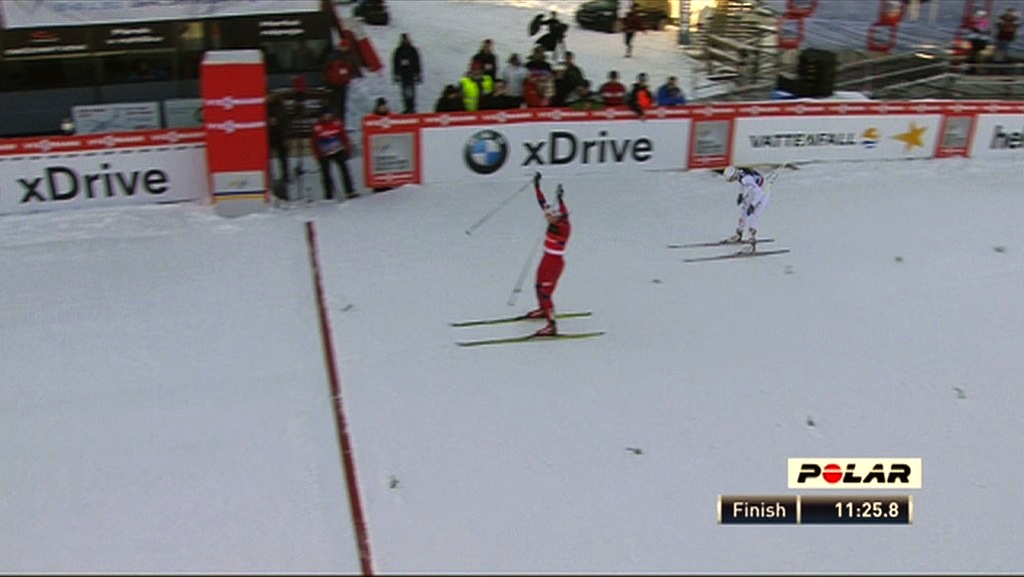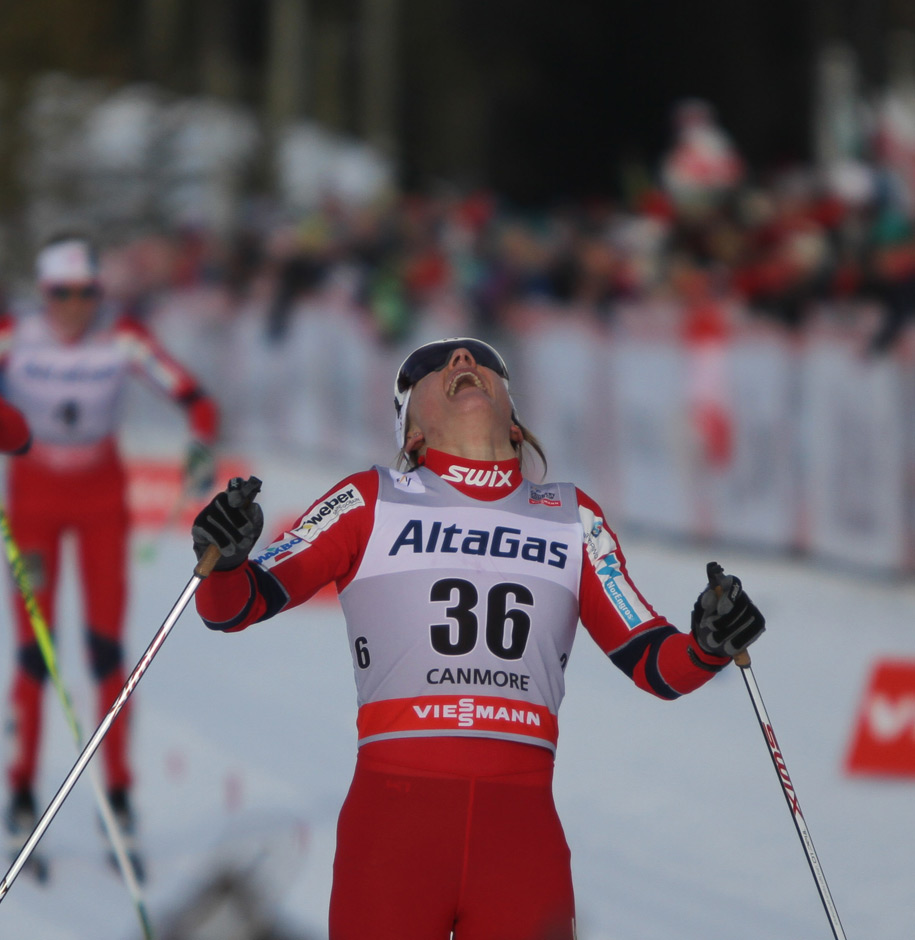
With two teammates alternating between six laps on the women’s 850-meter course in the World Cup freestyle team sprint in Liberec, Czech Republic, there was hardly enough time to get the skis off and another pair back on. As for catching your breath, forget it.
Tactics were essentially pointless. If you wanted to win, better get in front and stay there, hanging tough for the duration. But in a team sprint, which starts with a round of semifinals followed by a final, there are six total exchanges. One can ski clean throughout and mess up there, and well, it could be over.

Norway and Sweden had the right idea Sunday, getting ahead early in both the semifinal and final to secure top finishes in each. Maiken Caspersen Falla led Norway’s A-team to a triumphant victory in the final, challenging Sweden’s Ida Ingemarsdotter in the final 200 meters and beating her by 0.5 seconds in 11:26.2. Falla teamed up with Ingvild Flugstad Østberg for the win, and Sweden’s A-team of Ingemarsdotter and Stina Nilsson settled for second.
Sweden’s second team (Linn Soemskar/Magdalena Pajala) was third (+5.7), ahead of Germany, Switzerland, Russia and the U.S., respectively.
In the second semifinal, it was Norway’s B-team (Kari Vikahgen Gjeitnes/Celine Brun-Lie) that advanced in first with a time of 11:34.9. Sweden I placed second, Norway I was third and the lone U.S. women’s squad, with Sadie Bjornsen and Ida Sargent, made it through in fourth (+7.3).
Behind Switzerland (Bettina Gruber/Laurien van der Graaff) in fifth (+9.2), Canada’s Dasha Gaiazova and Perianne Jones was sixth (+12.0) and missed qualifying by a mere hundredth of a second.
Germany’s Nicole Fessel and Hannah Kolb won the first semifinal in a considerably slower time of 11:43.2, with Slovenia and Sweden II taking second and third, respectively.
Ten teams advanced to the final, where Norway II’s Gjeitnes made a point to lead early. Nilsson and Østberg stayed close in second and third on the first lap, and by the end of the leg (one of three apiece), the Americans had moved to third.
The race stayed in essentially the same order throughout the second leg, with Norway’s A-team moving to first, Sweden hanging in second, the U.S. in third, and Norway II and Germany around fourth. By the end of the leg, Norway II was back up front again with Brun-Lie and it appeared the Norwegians were working together ahead of Sweden. The Americans sat tight in fourth, then third, with two laps to go.
At the last exchange, things fell apart a bit for the Americans while the Norwegians and Swedes continued to push toward the finish.
“My last leg we kind of botched the tag and almost missed the end of the tag zone,” Sargent wrote in an email. “Norway and Sweden had a little gap and I tried to sprint to catch them to get the draft on the downhill, but I think I went too hard and really flooded with lactic acid. I had nothing left in the last few hundred meters and was doing everything I could just to stay on my feet and not fall over.”
Earlier in the day, Sargent and Bjornsen had another tag-off snafu on the last exchange.
“The semifinal was really good until the last tag when Sadie’s ski hit my pole and broke it,” Sargent explained. “I had to ski part of the first hill with one pole until I got another pole from the Norwegians, which was better than nothing but way too big for me. So I lost contact with the two Norwegian teams and Sweden, but I was able to hold off the teams behind us. Luckily our semifinal was a lot faster so we got a lucky loser spot.”
After finishing the final in seventh, Sargent said she was excited about her personal best in a team sprint, especially after she and Bjornsen placed 14th in the event last season in Milan, Italy.
“A year ago we raced a team sprint together in Milan and didn’t make the final and were barely hanging to the back of our semifinal,” Sargent wrote. “So to be in the fight today was really fun.”
After finishing behind two Norwegian teams and the Swedes in the semi, the Americans had confidence going into the final.
“We knew we could ski with the group,” Bjornsen wrote in an email. “The pace is of course always higher in the finals, so we had the plan of simply going when we could.”
At the top of the first big hill, Bjornsen said someone stepped on her pole and nearly pulled her glove and handle off, but she gripped tight and managed to keep it together. By the end of the first lap, Bjornsen was in sixth, and Sargent kept picking off the places until she reached the leaders.
“The fact that we were able to ski in 3rd for 95% of the race is exciting!” Bjornsen wrote. “[In Saturday’s individual sprint] we weren’t quite as happy, so today was a great way to finish the weekend on a positive note. It was much closer to our own expectations!”
At the front of the pack, Ingemarsdotter and Falla skied away from the group on the last lap. Brun-Lie attempted to go with them, but crashed into the fence on the curving descent before the stadium and ended up 10th. Meanwhile, Ingemarsdotter led into the final stretch, but Falla found another gear and overtook her before the finish.
“I was really not confident, but I was focusing on myself and pushing hard on the last lap,” the 22-year-old Falla told FIS News. “I knew I had more power left in the last hundred meters.”
For her 22-year-old teammate, Østberg, it was her first World Cup victory.
“It is the first time I stand on top of the podium,” Østberg told NRK, according to a translation. “I tried to save energy for the final round, and luckily we managed to get a [win]. I’m very pleased.”
In a race that didn’t allow much pacing, Ingemarsdotter said she tried to save some for the final lap.
“The last leg I just had to ski and give all my power,” she told FIS. “I’m really satisfied.”
Overall, the Canadians placed 11th after Gaiazova posted the fastest times in her second and third semifinal legs. She and Jones just missed a lucky-loser spot, but Gaiazova said that’s part of racing. After both notched career bests on Saturday, they struggled more on Sunday.
“Somebody stepped on [Peri’s] pole and the whole pole came off her hand at the bottom of an uphill,” Gaiazova explained. “She only was able to get a new one at the top of the hill so we lost some precious time there, but I guess it was just bad luck and it could happen to anyone.”
After the race, Gaiazova said she and Jones talked about where they could’ve made up that 0.01 second.
“It was really close and we wished we skied a bit better, but overall I was happy with my skiing,” she said.
Alex Kochon
Alex Kochon (alexkochon@gmail.com) is a former FasterSkier editor and roving reporter who never really lost touch with the nordic scene. A freelance writer, editor, and outdoor-loving mom of two, she lives in northeastern New York and enjoys adventuring in the Adirondacks. She shares her passion for sports and recreation as the co-founder of "Ride On! Mountain Bike Trail Guide" and a sales and content contributor at Curated.com. When she's not skiing or chasing her kids around, Alex assists authors as a production and marketing coordinator for iPub Global Connection.



